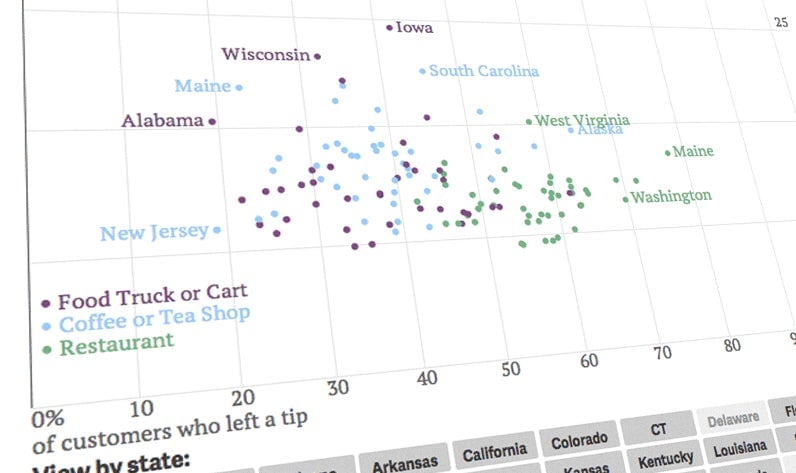Where the best and worst tippers in America live
Waiters in Nevada could use some more appreciation.


Waiters in Nevada could use some more appreciation.
Payment service Square provided Quartz with data on tens of millions of food-service transactions across the US. This shows that tips for waiters, baristas, and food-truck workers vary significantly according to location.
At restaurants, the national average tip is 16.5% of the bill, but falls to 14.6% in Nevada and rises to 20.1% in West Virginia.
At food trucks, the national average is a tad higher (17.6%), and the state-by-state average is even more volatile. In Iowa, where the most generous food-truck tippers live, patrons who tip add nearly 25% to their bills; in Pennsylvania and Georgia, the two cheapest states, eaters add less than 15% on average.
Coffee shop-goers are the most generous of all, according to Square’s data. The average tip left at cafes in the US is north of 18%, with South Carolina the best state for baristas, and Hawaii the worst.
There also seems to be quite a bit of disagreement about whether it’s appropriate to tip at all.
While nearly 80% of restaurant-goers in Maine leave a tip via Square, a mere 42% do the same in New Jersey. The average American only leaves a restaurant tip 57% of the time, according to Square’s data. While that might seem low, it likely reflects the sort of establishments that use Square’s services. Many of them charge at the counter, often before food is served or taken out. Charging after a meal gives diners the chance to evaluate service and quality, prompting a tip if they are particularly pleased.
At food trucks and coffee shops, there is a wide disparity in tipping behavior between states. More than two-thirds of Alaskans tip at coffee shops but only 19% of people in New Jersey do.
In North Dakota, food-truck goers reward their server 62% of the time, but in New York, the number drops to 22%. In Alabama, it’s barely more than 19%. The national average for food trucks is just above 37%.
It’s worth noting that Square’s data aren’t perfect. As we explained before, when we looked at tipping trends across all industries—not just food and drink—the tips it logs are only those paid with credit cards, not cash. Using plastic to pay the bill has been known to tempt customers into doling out a bit more than they would otherwise. Studies have shown that something as seemingly insignificant as putting a credit card insignia on restaurant tip trays can lead to bigger tips (pdf). And technology in general, fair or not, has been accused of encouraging what’s known as “guilt tipping.”